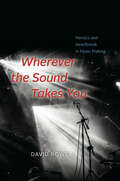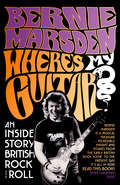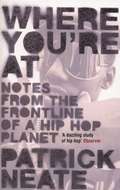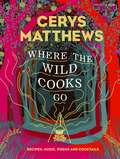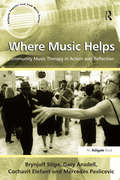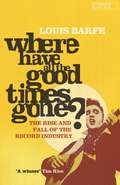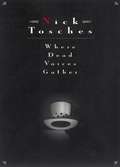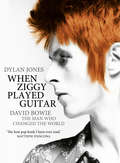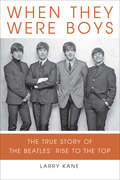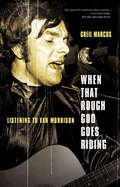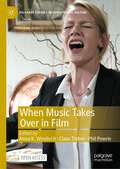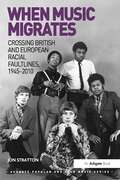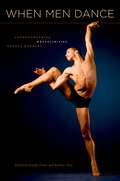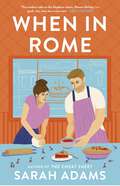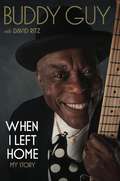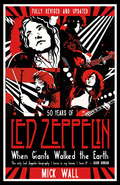- Table View
- List View
Wherever the Sound Takes You: Heroics and Heartbreak in Music Making
by David RowellDavid Rowell is a professional journalist and an impassioned amateur musician. He’s spent decades behind a drum kit, pondering the musical relationship between equipment and emotion. In Wherever the Sound Takes You, he explores the essence of music’s meaning with a vast spectrum of players, trying to understand their connection to their chosen instrument, what they’ve put themselves through for their music, and what they feel when they play. This wide-ranging and openhearted book blossoms outward from there. Rowell visits clubs, concert halls, street corners, and open mics, traveling from the Rock and Roll Hall of Fame in Cleveland to a death metal festival in Maryland, with stops along the way in the Swiss Alps and Appalachia. His keen reportorial eye treats us to in-depth portraits of musicians from platinum-selling legend Peter Frampton to a devout Christian who spends his days alone in a storage unit bashing away on one of the largest drum sets in the world. Rowell illuminates the feelings that both spur music’s creation and emerge from its performance, as well as the physical instruments that enables their expression. With an uncommon sensitivity and grace, he charts the pleasure and pain of musicians consumed with what they do—as all of us listen in.
Wherever the Sound Takes You: Heroics and Heartbreak in Music Making
by David RowellDavid Rowell is a professional journalist and an impassioned amateur musician. He’s spent decades behind a drum kit, pondering the musical relationship between equipment and emotion. In Wherever the Sound Takes You, he explores the essence of music’s meaning with a vast spectrum of players, trying to understand their connection to their chosen instrument, what they’ve put themselves through for their music, and what they feel when they play. This wide-ranging and openhearted book blossoms outward from there. Rowell visits clubs, concert halls, street corners, and open mics, traveling from the Rock and Roll Hall of Fame in Cleveland to a death metal festival in Maryland, with stops along the way in the Swiss Alps and Appalachia. His keen reportorial eye treats us to in-depth portraits of musicians from platinum-selling legend Peter Frampton to a devout Christian who spends his days alone in a storage unit bashing away on one of the largest drum sets in the world. Rowell illuminates the feelings that both spur music’s creation and emerge from its performance, as well as the physical instruments that enables their expression. With an uncommon sensitivity and grace, he charts the pleasure and pain of musicians consumed with what they do—as all of us listen in.
Wherever the Sound Takes You: Heroics and Heartbreak in Music Making
by David RowellDavid Rowell is a professional journalist and an impassioned amateur musician. He’s spent decades behind a drum kit, pondering the musical relationship between equipment and emotion. In Wherever the Sound Takes You, he explores the essence of music’s meaning with a vast spectrum of players, trying to understand their connection to their chosen instrument, what they’ve put themselves through for their music, and what they feel when they play. This wide-ranging and openhearted book blossoms outward from there. Rowell visits clubs, concert halls, street corners, and open mics, traveling from the Rock and Roll Hall of Fame in Cleveland to a death metal festival in Maryland, with stops along the way in the Swiss Alps and Appalachia. His keen reportorial eye treats us to in-depth portraits of musicians from platinum-selling legend Peter Frampton to a devout Christian who spends his days alone in a storage unit bashing away on one of the largest drum sets in the world. Rowell illuminates the feelings that both spur music’s creation and emerge from its performance, as well as the physical instruments that enables their expression. With an uncommon sensitivity and grace, he charts the pleasure and pain of musicians consumed with what they do—as all of us listen in.
Where’s My Guitar?: An Inside Story Of British Rock And Roll
by Bernie MarsdenA fascinating insight into the golden-age of 1970s and 80s rock and roll told through the eyes of music legend Bernie Marsden and, most notably, his role in establishing one of the world’s most famous rock bands of all time – Whitesnake.
Where You're At: Notes from the Frontline of a Hip Hop Planet
by Patrick NeatePinballing around the major cities of the world, from where it all began in the projects of Brooklyn and the Bronx to the excessive madness of Tokyo, from the random violence of Johannesburg, to the shanty towns of Rio, Whitbread Award-winning writer Patrick Neate explores the way how, through hip hop, the potent symbolism of black America has been acquired, used and subsumed by cultures on every continent to create a uniquely different form of globalism. A stunning musical journey and cultural odyssey, Where You're At is the story of how hip hop conquered the globe and nobody noticed.
Where the Wild Cooks Go: Recipes, Music, Poetry, Cocktails
by Cerys MatthewsA kitchen these days is a wonderful place. You can cook your way right round the world without spending a fortune and without even leaving your home. This is exactly what Cerys Matthews, food enthusiast, finds herself doing, with tried-and-tested recipes from all over the globe. Shall we go Spanish? Japanese? Scottish? Shall I cook inside? Light a fire?? Here, low-meat, vegan and vegetarian options, as well as cocktail recipes, offer up the world as your oyster. Accompanied by stories and folklore from each country, with a wonderful list of tracks to inspire while you cook and eat, this is a failsafe way to keep things interesting in the kitchen. With a recipe base and song list built over years of touring and discovering new places, Cerys has found that a simple list of ingredients and a great playlist on the go means there's always a ticket to ride.
Where Sight Meets Sound: The Poetics of Late-Medieval Music Writing (AMS Studies in Music)
by Emily ZazuliaThe main function of western musical notation is incidental: it prescribes and records sound. But during the fourteenth and fifteenth centuries, notation began to take on an aesthetic life all its own. In the early fifteenth century, a musician might be asked to sing a line slower, faster, or starting on a different pitch than what is written. By the end of the century composers had begun tasking singers with solving elaborate puzzles to produce sounds whose relationship to the written notes is anything but obvious. These instructions, which appear by turns unnecessary and confounding, challenge traditional conceptions of music writing that understand notation as an incidental consequence of the desire to record sound. This book explores innovations in late-medieval music writing as well as how modern scholarship on notation has informedsometimes erroneouslyideas about the premodern era. Drawing on both musical and music-theoretical evidence, this book reframes our understanding of late-medieval musical notation as a system that was innovative, cutting-edge, and dynamicone that could be used to generate music, not just preserve it.
Where Sight Meets Sound: The Poetics of Late-Medieval Music Writing (AMS Studies in Music)
by Emily ZazuliaThe main function of western musical notation is incidental: it prescribes and records sound. But during the fourteenth and fifteenth centuries, notation began to take on an aesthetic life all its own. In the early fifteenth century, a musician might be asked to sing a line slower, faster, or starting on a different pitch than what is written. By the end of the century composers had begun tasking singers with solving elaborate puzzles to produce sounds whose relationship to the written notes is anything but obvious. These instructions, which appear by turns unnecessary and confounding, challenge traditional conceptions of music writing that understand notation as an incidental consequence of the desire to record sound. This book explores innovations in late-medieval music writing as well as how modern scholarship on notation has informedsometimes erroneouslyideas about the premodern era. Drawing on both musical and music-theoretical evidence, this book reframes our understanding of late-medieval musical notation as a system that was innovative, cutting-edge, and dynamicone that could be used to generate music, not just preserve it.
Where Music Helps: Community Music Therapy in Action and Reflection (Ashgate Popular And Folk Music Ser.)
by Brynjulf StigeThis book explores how people may use music in ways that are helpful for them, especially in relation to a sense of wellbeing, belonging and participation. The central premise for the study is that help is not a decontextualized effect that music produces. The book contributes to the current discourse on music, culture and society and it is developed in dialogue with related areas of study, such as music sociology, ethnomusicology, community psychology and health promotion. Where Music Helps describes the emerging movement that has been labelled Community Music Therapy, and it presents ethnographically informed case studies of eight music projects (localized in England, Israel, Norway, and South Africa). The various chapters of the book portray "music's help" in action within a broad range of contexts; with individuals, groups and communities - all of whom have been challenged by illness or disability, social and cultural disadvantage or injustice. Music and musicing has helped these people find their voice (literally and metaphorically); to be welcomed and to welcome, to be accepted and to accept, to be together in different and better ways, to project alternative messages about themselves or their community and to connect with others beyond their immediate environment. The overriding theme that is explored is how music comes to afford things in concert with its environments, which may suggest a way of accounting for the role of music in music therapy without reducing music to a secondary role in relation to the "therapeutic," that is, being "just" a symbol of psychological states, a stimulus, or a text reflecting socio-cultural content.
Where Music Helps: Community Music Therapy In Action And Reflection (Ashgate Popular And Folk Music Ser.)
by Brynjulf StigeThis book explores how people may use music in ways that are helpful for them, especially in relation to a sense of wellbeing, belonging and participation. The central premise for the study is that help is not a decontextualized effect that music produces. The book contributes to the current discourse on music, culture and society and it is developed in dialogue with related areas of study, such as music sociology, ethnomusicology, community psychology and health promotion. Where Music Helps describes the emerging movement that has been labelled Community Music Therapy, and it presents ethnographically informed case studies of eight music projects (localized in England, Israel, Norway, and South Africa). The various chapters of the book portray "music's help" in action within a broad range of contexts; with individuals, groups and communities - all of whom have been challenged by illness or disability, social and cultural disadvantage or injustice. Music and musicing has helped these people find their voice (literally and metaphorically); to be welcomed and to welcome, to be accepted and to accept, to be together in different and better ways, to project alternative messages about themselves or their community and to connect with others beyond their immediate environment. The overriding theme that is explored is how music comes to afford things in concert with its environments, which may suggest a way of accounting for the role of music in music therapy without reducing music to a secondary role in relation to the "therapeutic," that is, being "just" a symbol of psychological states, a stimulus, or a text reflecting socio-cultural content.
Where Have All the Good Times Gone?: The Rise And Fall Of The Record Industry
by Louis BarfeLouis Barfe's elegantly written, authoritative and highly entertaining history charts the meteoric rise and slow decline of the popular recording industry. Barfe shows how the 1920s and 1930s saw the departure of Edison from the phonograph business he created and the birth of EMI and CBS. In the years after the war, these companies, and the buccaneers, hucksters, impresarios and con-men who ran them, reaped stupendous commercial benefits with the arrival of Elvis Presley, who changed popular music (and sales of popular music) overnight. After Presley came the Beatles, when the recording industry became global and record sales reached all time highs. Where Have All The Good Times Gone? also charts the decline from that high-point a generation ago. The 1990s ushered in a period of profound crisis and uncertainty in the industry, encapsulated in one word: Napster. Barfe shows how the almost infinite amounts of free music available online have traumatic and disastrous consequences for an industry that has become cautious and undynamic.
Where Dead Voices Gather
by Nick ToschesA forgotten singer from the early days of jazz is at the center of this riveting book -- a narrative that is part mystery, part biography, part meditation on the meaning and power of music.
When Ziggy Played Guitar: David Bowie, The Man Who Changed The World
by Dylan JonesAnd then there was David Bowie, the uber-freak with the mismatched pupils, the low-tech space face from the planet Sparkle. This was Bowie's third appearance on TOTP but this was the one that properly resonated with its audience, the one that would go on to cause a seismic shift in the Zeitgeist. This is the performance that turned Bowie into a star, embedding his Ziggy Stardust persona into the nation's consciousness. With a tall, flame-orange cockade quiff (stolen from a Kansai Yamamoto model on the cover of Honey), lavishly applied make-up, white nail polish, and wearing a multi-coloured jump-suit that looked as though it were made from fluorescent fish skin (chosen by Ziggy co-shaper, the designer Freddie Buretti), and carrying a brand spanking new, blue acoustic guitar, a bone-thin Bowie appeared not so much as a pop singer, but rather as some sort of benevolent alien, a concept helped along by the provocative appearance of his guitarist, the chicken-headed Mick Ronson, with both of them unapologetically sporting knee-length patent leather wrestler's boots (Bowie's were red). 'Most people are scared of colour,' Bowie said later. 'Their lives are built up in shades of grey. It doesn't matter how straight the style is, make it brightly coloured material and everyone starts acting weird.' Suddenly Bowie - a man called alias - had the world at his nail-varnished fingertips, and in no time at all he would be the biggest star in the world.
When They Were Boys: The True Story of the Beatles' Rise to the Top
by Larry Kane"Larry Kane was the only broadcast journalist to travel with the Beatles on their triumphant 1964 and '65 North American tours.... Combining the results of some deep digging and revealing interviews with those who knew them best, Kane unearths fascinating details from the earliest days of the boys' growing up in hardscrabble Liverpool in the 1950s to the eve of their world conquest in 1964" (Christian Science Monitor). This is the story of the Beatles' harrowing rise to fame: focusing on that seven-year stretch from the time the boys met as teenagers to early 1964, when the Fab Four made their momentous first appearance on The Ed Sullivan Show. From the boys' humble beginnings in Liverpool, to the cellars of Hamburg, When They Were Boys includes stories never before told, including the heartbreaks and the lucky breaks. Included are an eyewitness account of that first meeting between Lennon and McCartney, the inside story of how Ringo replaced Pete Best, an exploration of the brilliant but troubled soul of manager Brian Epstein, and the real scoop on their disastrous first visit to Germany and the death of Stu Sutcliffe. With an eye for life in Liverpool during the 50's and 60's and over 65 eyewitness accounts from those closest to the Beatles, Larry Kane brings to life theevolution of the group that changed music forever.
When They Were Boys: The True Story of the Beatles' Rise to the Top
by Larry KaneThis is the story of the Beatles' harrowing rise to fame: focusing on that seven-year stretch from the time the boys met as teenagers to early 1964, when the Fab Four made their momentous first appearance on The Ed Sullivan Show. From the boys' humble beginnings in Liverpool, to the cellars of Hamburg, When They Were Boys includes stories never before told, including the heartbreaks and the lucky breaks. Included are an eyewitness account of that first meeting between Lennon and McCartney, the inside story of how Ringo replaced Pete Best, an exploration of the brilliant but troubled soul of manager Brian Epstein, and the real scoop on their disastrous first visit to Germany and the death of Stu Sutcliffe. With an eye for life in Liverpool during the 50's and 60's and over 65 eyewitness accounts from those closest to the Beatles, Larry Kane brings to life the evolution of the group that changed music forever.
When That Rough God Goes Riding: Listening to Van Morrison
by Greil MarcusThis book is a quest to understand Van Morrison's particular genius through a close look at the most extraordinary and unclassifiable moments in his long career, beginning in 1965 and continuing in full force to this day: sometimes entire songs, sometimes single words or even the guttural spaces between words that become musical events in themselves.
When Music Takes Over in Film (Palgrave Studies in Audio-Visual Culture)
by Anna K. Windisch Claus Tieber Phil PowrieThis open access collection deals with musical moments in film as one of the most pivotal and compelling issues of current film music research. Musical moments as defined by Amy Herzog occur when a musical number inverts the normal relationship between the image track and the soundtrack in a film in such a way that what we see is determined by what we hear. As one potential approach, this definition provokes a variety of perspectives to investigate the disruptive potential of these moments and numbers as a creative device in the production of audiovisual narratives. In this sense, the book responds to a need for an anthology that introduces students as well as scholars of cinema, musicology, media studies and cultural studies more broadly, to recent discourses in film music scholarship. The volume includes contributions by early career researchers as well as by established experts in the fields of musicology, film studies, media studies, and cultural studies, promoting cross-disciplinary collaboration in film music research.
When Music Migrates: Crossing British and European Racial Faultlines, 1945–2010 (Ashgate Popular and Folk Music Series)
by Jon StrattonWhen Music Migrates uses rich material to examine the ways that music has crossed racial faultlines that have developed in the post-Second World War era as a consequence of the movement of previously colonized peoples to the countries that colonized them. This development, which can be thought of in terms of diaspora, can also be thought of as postmodern in that it reverses the modern flow which took colonizers, and sometimes settlers, from European countries to other places in the world. Stratton explores the concept of ’song careers’, referring to how a song is picked up and then transformed by being revisioned by different artists and in different cultural contexts. The idea of the song career extends the descriptive term ’cover’ in order to examine the transformations a song undergoes from artist to artist and cultural context to cultural context. Stratton focuses on the British faultline between the post-war African-Caribbean settlers and the white Britons. Central to the book is the question of identity. For example, how African-Caribbean people have constructed their identity in Britain can be considered through an examination of when ’Police on My Back’ was written and how it has been revisioned by Lethal Bizzle in its most recent iteration. At the same time, this song, written by the Guyanese migrant Eddy Grant for his mixed-race group The Equals, crossed the racial faultline when it was picked up by the punk-rock group, The Clash. Conversely, ’Johnny Reggae’, originally a pop-ska track written about a skinhead by Jonathan King and performed by a group of studio artists whom King named The Piglets, was revisioned by a Jamaican studio group called The Roosevelt Singers. After this, the character of Johnny Reggae takes on a life of his own and appears in tracks by Jamaican toasters as a Rastafarian. Johnny’s identity is, then, totally transformed. It is this migration of music that will appeal not only to those studying popular music, but
When Music Migrates: Crossing British and European Racial Faultlines, 1945–2010 (Ashgate Popular and Folk Music Series)
by Jon StrattonWhen Music Migrates uses rich material to examine the ways that music has crossed racial faultlines that have developed in the post-Second World War era as a consequence of the movement of previously colonized peoples to the countries that colonized them. This development, which can be thought of in terms of diaspora, can also be thought of as postmodern in that it reverses the modern flow which took colonizers, and sometimes settlers, from European countries to other places in the world. Stratton explores the concept of ’song careers’, referring to how a song is picked up and then transformed by being revisioned by different artists and in different cultural contexts. The idea of the song career extends the descriptive term ’cover’ in order to examine the transformations a song undergoes from artist to artist and cultural context to cultural context. Stratton focuses on the British faultline between the post-war African-Caribbean settlers and the white Britons. Central to the book is the question of identity. For example, how African-Caribbean people have constructed their identity in Britain can be considered through an examination of when ’Police on My Back’ was written and how it has been revisioned by Lethal Bizzle in its most recent iteration. At the same time, this song, written by the Guyanese migrant Eddy Grant for his mixed-race group The Equals, crossed the racial faultline when it was picked up by the punk-rock group, The Clash. Conversely, ’Johnny Reggae’, originally a pop-ska track written about a skinhead by Jonathan King and performed by a group of studio artists whom King named The Piglets, was revisioned by a Jamaican studio group called The Roosevelt Singers. After this, the character of Johnny Reggae takes on a life of his own and appears in tracks by Jamaican toasters as a Rastafarian. Johnny’s identity is, then, totally transformed. It is this migration of music that will appeal not only to those studying popular music, but
When Music Mattered: American Music in the Sixties
by James WierzbickiThis book examines the American Sixties, and how that period’s socio-political essence was reflected and refracted in certain forms of the period’s music. Its five main chapters bear the names of familiar musical categories: ’Folk,’ ‘Rock,’ ‘Jazz,’ ‘Avant-Garde,’ ‘Classical.’ But the book’s real subject matter—treated at length in the Prologue and the Epilogue but spread throughout all that comes between—is the Sixties’ tangled mess of hopes and frustrations, of hungers as much for self-identity as for self-indulgence, of crises of conscience that bothered Americans of almost all ages and regardless of political persuasion.
When Men Dance: Choreographing Masculinities Across Borders
by Jennifer FisherWhen Men Dance explores the intersection of dance and perceptions of male gender and sexuality across history and different cultural contexts. Chapters tackle the history and dilemmas that revolve around dance and notions of masculinity from a variety of dance studies perspectives, and are accompanied by fascinating personal histories that complement their themes.
When Men Dance: Choreographing Masculinities Across Borders
by Jennifer Fisher Anthony ShayWhen Men Dance explores the intersection of dance and perceptions of male gender and sexuality across history and different cultural contexts. Chapters tackle the history and dilemmas that revolve around dance and notions of masculinity from a variety of dance studies perspectives, and are accompanied by fascinating personal histories that complement their themes.
When in Rome: The charming new rom-com from the author of the TikTok sensation, THE CHEAT SHEET!
by Sarah AdamsA burned-out pop star stranded in small-town Kentucky can't help falling for her unlikely knight in shining armour - the notoriously grumpy owner of the local pie shop - in this charming slice of romance from the author of the TikTok sensation The Cheat Sheet.'This modern take on the Hepburn classic Roman Holiday is a quick, fun, slow-burn rom-com' ABBY JIMENEZ'Sarah Adams has written the Kentucky-set homage to Roman Holiday I never knew I needed. Full of cozy small-town vibes, a pie-baking hero (swoon!), and a slow-burn romance that will keep you flipping the pages, When in Rome is a charming and comforting escape' KERRY WINFREY'My Audrey Hepburn loving heart is so happy! When in Rome is a delectable romance, sweet and satisfying as a slice of warm apple pie' CHLOE LIESE 'Sarah Adams' books are woven with pure sunshine and rainbows . . . It's everything you could want in a small-town romance, along with a heaping dollop of her signature wit and sparkling charm' AMY LEA'You can always count on a Sarah Adams rom-com to be equal parts funny, sweet, and swoony' SOPHIE SULLIVAN.......................................Rome is where the heart is.Amelia Rose is burned-out from years of maintaining her public image as pop princess Rae Rose. Inspired by her favourite Audrey Hepburn film, Roman Holiday, she drives off in the middle of the night for a break in Rome . . . Rome, Kentucky, that is. Running the pie shop his grandmother left him, Noah Walker is busy enough as it is. But after finding Amelia on his front lawn in her broken-down car, he decides to let her stay in his guest room - on a very temporary basis, of course. As the two of them grow closer, Noah starts to see a new side to Amelia - kind-hearted and goofy, yet lonely from years in the public eye. Amelia may have to go back to her other life someday, but for now she's perfectly happy falling in love with the cozy small town she's found herself in . . . and her grumpy tour guide isn't half-bad either.........................................Discover The Cheat Sheet - the heartwarming friends-to-lovers romance that became a sensation on TikTok!'I just adored this story . . . I'm ready to eat up anything that Sarah Adams writes' 'A perfect mix of hilarious banter, comical situations, and sweet romance' 'This romance is brilliant! It is fast paced, laugh out loud and so cute!''A feel-good rom-com with everything you want in a romance!'
When I Left Home: My Story
by Buddy GuyAccording to Eric Clapton, John Mayer, and the late Stevie Ray Vaughn, Buddy Guy is the greatest blues guitarist of all time. An enormous influence on these musicians as well as Jimi Hendrix, Jimmy Page, and Jeff Beck, he is the living embodiment of Chicago blues. Guy's epic story stands at the absolute nexus of modern blues. He came to Chicago from rural Louisiana in the fifties-the very moment when urban blues were electrifying our culture. He was a regular session player at Chess Records. Willie Dixon was his mentor. He was a sideman in the bands of Muddy Waters and Howlin' Wolf. He and Junior Wells formed a band of their own. In the sixties, he became a recording star in his own right.When I Left Home tells Guy's picaresque story in his own unique voice, that of a storyteller who remembers everything, including blues masters in their prime and the exploding, evolving culture of music that happened all around him.
When Giants Walked the Earth: A Biography Of Led Zeppelin
by Mick WallThe definitive final word on the world's greatest rock band, Led Zeppelin. Over ten years after WHEN GIANTS WALKED THE EARTH, Mick's seminal biography of the band, comes this major and extensively researched revision, which will provide an unflinching look at life inside one of the biggest-selling rock bands of all time, and present the definitive, final word on Led Zeppelin.They were 'the last great band of the sixties; the first great band of the seventies'; they rose, somewhat unpromisingly, from the ashes of the Yardbirds to become one of the biggest-selling rock bands of all time. Mick Wall, respected rock writer and former confidant of both Page and Plant, unflinchingly tells the story of the band that wrote the rulebook for on-the-road excess - and eventually paid the price for it, with disaster, drug addiction and death. WHEN GIANTS WALKED THE EARTH reveals for the first time the true extent of band leader Jimmy Page's longstanding interest in the occult, and goes behind the scenes to expose the truth behind their much-hyped yet spectacularly contrived comeback at London's O2 arena in 2007, and how Jimmy Page plans to bring the band back permanently - if only his former protégé, now part-time nemesis, Robert Plant will allow him to. Wall also recounts, in a series of flashbacks, the life stories of the five individuals that made the dream of Led Zeppelin into an even more incredible and hard-to-swallow reality: Page, Plant, John Paul Jones, John Bonham, and their infamous manager, Peter Grant.
